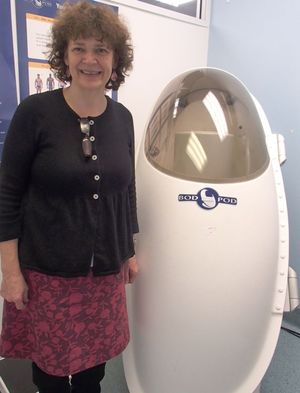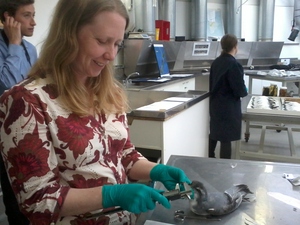Our Changing World for Thursday 31 October 2013
Measuring Body Fat with a Bodpod
 The world is experiencing an obesity epidemic. According to the World Health Organisation at least 2.8 million adults each year die as a result of being overweight or obese, and overweight and obesity are the fifth leading risk for global deaths. BMI or body mass index is a useful measure of a population’s weight status, but researchers studying individuals need a more precise way of measuring body composition, and working out how fat someone is. One way is to use a machine called the Bod Pod.
The world is experiencing an obesity epidemic. According to the World Health Organisation at least 2.8 million adults each year die as a result of being overweight or obese, and overweight and obesity are the fifth leading risk for global deaths. BMI or body mass index is a useful measure of a population’s weight status, but researchers studying individuals need a more precise way of measuring body composition, and working out how fat someone is. One way is to use a machine called the Bod Pod.
A Bod Pod uses Air Displacement Plethysmography technology – basically, the subject’s height and weight is measured, which gives a measurement of mass. Then the Bod Pod measures the amount of air the person displaces. From the equation Density = Mass/Volume and using ratios derived from cadavers, the proportions of fat and lean mass can then be calculated.
Jane Coad (left) from the Institute for Food, Nutrition and Human Health Massey University uses a Bod Pod in her studies of human health and nutrition. She offers to show Alison Ballance how it works, which is how Alison finds herself conducting an interview in a swimsuit, and becoming the test subject in the Bodpod. Massey University researcher Louise Brough also brings in her baby Barney, who bares all for the story to demonstrate the Pea Pod, a miniature Bod Pod designed especially for babies.
Jane is currently recruiting pregnant women in the Manawatu for a study assessing the relationship between changes in maternal and infant body composition. The body composition of both mothers and babies will be measured in the Bod Pod and Pea Pod at various times after birth. You can contact Jane Coad on 06 3505962 or Chris Booth on 0800 080028.
Spirit of Mawson
Douglas Mawson was an Australian geologist and Antarctic explorer, and along with Roald Amundsen, Robert Falcon Scott and Ernest Shackleton, he was a key expedition leader during the Heroic Age of Antarctic exploration. He first travelled to Antarctica as part of Shackleton’s British Antarctic Expedition, aboard the Nimrod. In March 1908, he was one of the first party to climb Mount Erebus, and the following summer Edgeworth David, A. F. Mackay and Mawson were the first to reach the vicinity of the South Magnetic Pole, manhauling their sledges for more than 2000km.
In December 1911, with substantial private and government backing, Mawson set sail again to lead the Australasian Antarctic Expedition. His teams pursued scientific investigations in many disciplines, including geology, cartography, geomagnetism and biology from the three bases they established, as well an extensive marine science programme from aboard the Aurora.
In November 2013, the Spirit of Mawson expedition will retrace Mawson's voyage and carry out research across the region, building on the work 100 years ago, to try to better understand present and future change in Antarctica and the Southern Ocean. Veronika Meduna will take part the first leg of the expedition to join scientists as they explore the subantarctic islands to study climatic change and its impact on the islands' ecology.
Adult Stem Cells

From left to right: Jim Faed, Paul Turner and Way Wong (images: Spinal Cord Society of New Zealand)
An adult stem cell is an undifferentiated cell that can renew itself and differentiate into other specialised cells. Mesenchymal stromal cells are a type of adult stem cell found in bone marrow. These cells can form bone, cartilage, fat cells, and other kinds of connective tissue cells, such as those in tendons.
Jim Faed from the University of Otago, and the Spinal Cord Society of New Zealand, is researching mesenchymal stromal cells, with the hope that one day these cells can be used to treat spinal cord injury.
In the first instance though, he is looking at using these cells to control immune cells in people with type 1 diabetes. Over 20,000 people in New Zealand have type 1 diabetes, an auto-immune disease where the body produces no, or very little, insulin. A previous study has shown that exposing white blood cells to mesenchymal stromal cells down-regulates T cells, and improves insulin production in people with type 1 diabetes. While follow up studies need to be conducted to show if this benefit is long lasting, and clinical trials are some way off, Jim Faed, Paul Turner and Way Wong are working on optimising methods for growing mesenchymal stromal cells. They explain to Ruth Beran that the next step will be to set up a production plant where the adult stem cells can be expanded to sufficiently large numbers to be used in planned trials.
Mystery of the Whalebirds
Some of the broad-billed prions that have been kept at Te Papa since the 2011 storm. (images: V Meduna)
In July 2011, a massive storm moved across New Zealand and beach-wrecked more than a quarter of a million prions, also known as whalebirds, along the west coast, from Dargaville to Okarito. Prions are small blue-grey petrels, among the most abundand of New Zealand birds, and they typically breed in large colonies on remote, predator-free islands. There are six species of these small seabirds, which vary mostly in the width and size of their beaks. Most of the birds killed in the 2011 storm were broad-billed prions, the largest of the species.
 Hundreds of the dead seabirds have since been kept frozen in storage at Te Papa’s laboratories, and last week, a team of scientists came together for a Science Live session to examine some of them to find out why so many had died and what that means for their population. In this interview, Te Papa behavioural ecologist Sarah Jamieson (pictured on the left taking measurements of a broad-billed prion), bird taxonomists Colin Miskelly and Alan Tennyson, senior curator Susan Waugh and visiting student Elizabeth Crotty explain the impact the storm event had on the prion populations breeding around and south of Rakiura Stewart Island. You can also read blogs written by the scientists focusng on prion evolution, their marine habitat and their foraging ecology.
Hundreds of the dead seabirds have since been kept frozen in storage at Te Papa’s laboratories, and last week, a team of scientists came together for a Science Live session to examine some of them to find out why so many had died and what that means for their population. In this interview, Te Papa behavioural ecologist Sarah Jamieson (pictured on the left taking measurements of a broad-billed prion), bird taxonomists Colin Miskelly and Alan Tennyson, senior curator Susan Waugh and visiting student Elizabeth Crotty explain the impact the storm event had on the prion populations breeding around and south of Rakiura Stewart Island. You can also read blogs written by the scientists focusng on prion evolution, their marine habitat and their foraging ecology.
Some of the best preserved prions have been turned into mounts or skins which can be used for future studies. The oldest such bird skin in Te Papa's collections is in fact a broad-billed prion, which was collected from th Chatham Islands almost 150 years ago. A broad-billed prion was also the first New Zealand bird to be given a scientific name in 1777 during Captain Cook's second voyage.
Mawson's chief magnetician, Eric Webb
New Zealander Eric Webb recalls his time as chief magnetician on Douglas Mawson's Australasian Antarctic Expedition 1913-14, in this archiveal interview from Nga Taonga Korero, New Zealand's sound archives.
